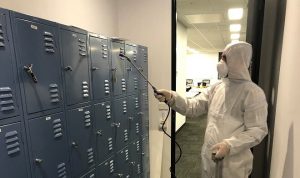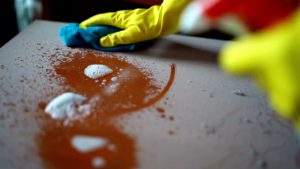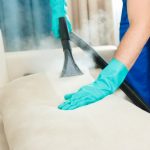
The year 2020 has been marked with a new viral infection, which has popularised the cleaning technique called fogging. Before the appearance of COVID-19, disinfectant fogging was performed sparingly as a highly specialised cleaning technique for sanitising interior spaces mainly in health care and food processing industries. Nowadays, fogging has become a daily occurrence as a weapon against this new invisible enemy. While some of you will still approach this technique with caution, many have welcomed it as part of a regular clean to disinfect classrooms and other high-traffic areas. But, is this wise?
WHAT IS FOGGING?
Fogging is a technique of dispersing a very fine mist of chemical disinfectants onto surfaces and in the air. The droplets expelled from the fogger are so tiny that they can remain suspended in the air long enough to kill airborne viruses and bacteria.
Moreover, the aerosolised disinfectant can reach places that are hard to clean such as walls, ceilings, cupboards, as well as crevices of the objects that are being treated. As the fog passes through the cracks, it clings to the surface and applies the disinfectant. In most cases, it is therefore not necessary to move furniture or equipment around during the process.
WHAT CAN BE TREATED WITH FOGGING?

Fogging is safe for all the surfaces and materials, hard or soft. Wet fogging, however, will produce larger droplets, anywhere between 10 and 100 microns which will leave surfaces wet once the mist settles. Wiping excess disinfectant will therefore be required after the treatment. In rooms where there is a lot of electrical equipment, dry fogging is a preferred method. For this method, higher pressure and fine bore nozzle will be used to produce uniformly fine droplets under 10 microns in size, much like smoke, and will leave the surfaces dry.
IS FOGGING EFFICIENT?
Disinfectant fogging, when carried out properly is a rapid and efficient way of applying disinfectants to a large area as opposed to physical sanitising. To ensure full effectiveness of this technique, the following requirements must be met:

-
-
-
-
-
- The disinfectant must reach the target areas.
- A certain concentration of disinfectant must be achieved to be effective.
- It must be given enough time to work before the surfaces are wiped.
- For best results, thorough physical cleaning with detergent and warm water is required prior to fogging to remove dirt and grime on which the germs feed.
-
-
-
-
IS IT SAFE?
The growing demand for higher levels of sanitation over the past years has seen a great progress in developing chemicals that are safe when used correctly. There are however risks of allergic reactions, therefore fogging must be performed once all the areas are cleared of people. This is best done outside business hours or over the weekend, that will also allow ample time for the mist to disperse after the procedure. Fogging should always be carried out by a trained team of professionals who have the proper knowledge, experience and equipment to minimise any potential health and safety risks.
WHAT ARE THE DRAWBACKS OF FOGGING?
Like they say, “Too much of anything is bad”, the same goes for fogging. Although this technique is a good way to combat viruses and bacteria, expert advice and warning should be followed.
- Fogging can only produce the desired results if it is carried out properly, without rushing it, and in conjunction with mechanical cleaning. A disinfectant can kill germs only when it makes full contact with them, so surfaces that are partly covered in dirt, wet patches, or other matter, may not be sanitised.

- Prolonged exposure to fogging chemicals may cause potential health and safety risks such as irritation of the skin, eye, and respiratory system. The population that is most affected by these issues are cleaners and vulnerable occupants such as infants and asthmatics.
- Chemical disinfectants also penetrate fabrics such as soft furnishings, blinds and carpets, where they can remain for a long time after the treatment. It is therefore recommended to get them steam cleaned to eliminate as much residue as possible and further minimise the potential health risks from exposure.
WHEN IS FOGGING RECOMMENDED?

Unless you are working in the industry with a high risk of viral and bacterial contamination, disinfectant fogging is best practiced as a response to an infectious outbreak. It is not however recommended as part of the routine sanitising due to the potential health and safety risks it may pose on a long run.
Chlorine and hydrogen peroxide-based chemicals can cause irritation and allergic reactions, while alcohol-based disinfectants are flammable and pose a fire hazard.
It is therefore highly recommended to practice physical cleaning and sanitising on a daily basis. The attention should be placed on all the surfaces that are most frequently touched, such as door handles, light switches, handrail, tabletops, telephones, lift buttons, trolley handles etc.
Proper cleaning involves wiping the surfaces with a detergent dissolved in warm water, followed by sanitising with a hospital grade disinfectant. If you are dealing with larger spaces, a 2-in-1 solution combining a cleaning and disinfectant agent will also be effective. These few simple steps when done regularly will be enough to help provide a safe and healthy environment for all the occupants.
Take care of yourselves, and each other!
Due to COVID-19 pandemic, Cleanaux has incorporated disinfecting into each scheduled cleaning service since March 2020, as per the government recommendations. Our emergency response team for bio-hazard cleaning is also on standby and ready to respond quickly and efficiently. If you are affected by an infectious outbreak, contact us as soon as possible on 1300 277 009 or 0422 724 528 outside business hours. For more information, please click here >>> COVID-19 CLEANING SERVICES.
